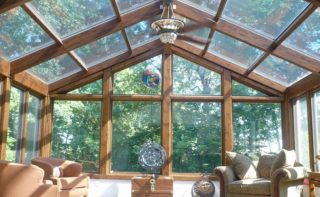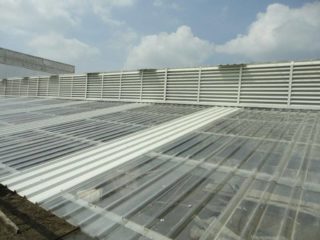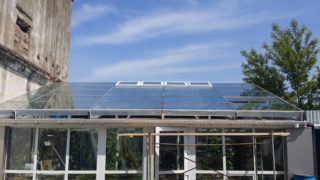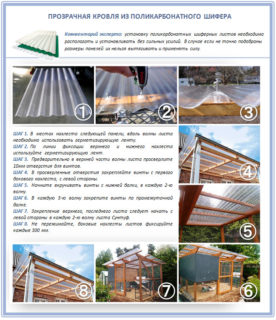A transparent roof allows more sunlight to enter the room. Due to this, this design is often used in greenhouse and greenhouse structures, gazebos and other premises.
Varieties of transparent roofing materials

The transparent roof is made of different types of materials - metal tiles, polycarbonate, a special coating based on polyvinyl chloride. They differ in properties and preferred applications.
Plexiglass
A transparent roof for a terrace is made of plexiglass and is used in structures that are difficult to equip, for example, greenhouses or arched ceilings. This is helped by the properties of the material. It differs from ordinary glass in much greater strength (it is 5 times higher), with a lower mass. Plexiglass provides protection from ultraviolet radiation to the plants and objects underneath. The material does not change color under the influence of the sun.
Polycarbonate
A transparent roof for a canopy or a greenhouse structure is made of honeycomb material. It is also used in urban buildings, for example, for the arrangement of galleries. The breadth of the scope of use is due to the lightness of the material. Like plexiglass, it is suitable for buildings that need thermal insulation. Monolithic forms are suitable for vandal-proof glazing. Since polycarbonate bends in a high-temperature environment, curved structures are made from it.
Corrugated PVC

Translucent materials are made of PVC and vinyl, serving to replace the traditional euro slate. They are used to create a transparent roof covering or for the installation of window structures in the roof. Consumers are attracted by the lightness of the material.
Transparent corrugated board
Transparent corrugated roof sheeting is made of plastic. It has the same dimensions and shape as its metal counterpart. Transparent corrugated sheet is sometimes used to decorate walls; inserts are made from it in enclosing structures for light access.
Triplex
The material consists of bonded glass sheets, some of which have been hardened. From above, the triplex is covered with a film composition. Under mechanical stress, it will not crack, as happens with glass. Instead, a crumb appears that settles on the film.
Reinforced polyester
Contains fiberglass and ester resins. The material is produced in the form of rolls or in sheet form. The surface is usually smooth, but may have waves.
Fiberglass is popular due to its cost-effectiveness and ease of installation. It is used in the construction of verandas, greenhouses, buildings for animal husbandry, fences, stadiums and in a number of other structures.
Features and characteristics

A roof for a terrace made of traditional glass is practically not found. This is due to the fragility of the material and its high risk of injury when it falls out of a wooden frame or frame. There are many translucent materials that do not have these disadvantages. When using them, you do not need to be afraid to get injured from careless movement. The selection of material is carried out in accordance with the purpose of the room and the features of the installation.
Translucent roofing is usually used in non-residential premises: indoor swimming pools, greenhouses, verandas and other buildings located on the territory of the site. It is used to make a carport.
The advantages of transparent roofing material are:
- increased penetration of sunlight into the room;
- impermeability to precipitation and ultraviolet radiation;
- high strength of many materials and resistance to corrosion processes;
- visual increase in space;
- attractive appearance;
- the ability to make the coating in different shapes and colors.
In residential buildings, as a rule, such solutions are not used. The lack of a visually impenetrable roof over their heads makes most people feel mentally vulnerable. In addition, such coatings are not compatible with all types of structures and do not have sufficient heat-shielding characteristics, which are important for dwellings located in a cold region.
DIY installation
The slope of the roof should also be taken into account: for steep versions, the load on the sheet is minimal. When performing work, it is important to minimize the mechanical pressure on the created roof (for example, it is forbidden to step on it). So that moisture does not condense in the structure, it must be well ventilated. This is especially true for the area under the roof. The film cover can be removed at the end of the work.
Rules for the care of a transparent roof
Usually, such designs do not differ in demanding care. The surface is well cleaned naturally with rainwater. If it is necessary to specifically wash the roof, soapy water and a soft sponge that does not contain abrasive components are suitable.
With proper installation, the roof will last up to half a century. The service life depends on the material used.









